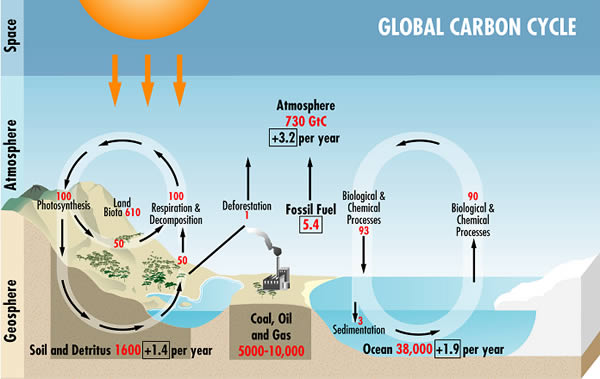 Activity 7: Carbon on the Move
Activity 7: Carbon on the Move
Overview
This activity serves as an introduction to the carbon cycle, with an emphasis on the role of forests in the cycle. The simulation portion of the activity involves students moving through the pools and fluxes of the biological carbon cycle. Then group work and class discussion provide concepts about the geological carbon cycle and how to put the two together in the context of fossil fuel combustion.
Downloads
Full Activity (with student pages included)
Student Pages
Presentations and Teacher Notes
Answer Key
Supporting Materials
Links
Activity 7 or check out Additional Resources for the entire module.
- All About Carbon Dioxide, A Student’s Guide to Global Climate Change – U.S. Environmental Protection Agency website with a video about the carbon cycle and human influence on carbon.
- Global Warming: It’s All about Carbon – National Public Radio series containing five short videos about carbon and its role in climate change.
- GLOBE Carbon Cycle – Education unit with activities to help students understand the carbon cycle, including a “choose your own adventure story.”
- Climate Science Info Zone – London Science Museum’s interactive website containing animations and videos related to the global climate, the carbon cycle, and climate change.
- Steroids and Baseball – Short video that uses steroids in baseball as an analogy to carbon dioxide in climate.
- The Carbon Cycle – Online article by the National Aeronautics and Space Administration (NASA) with many photos, diagrams, graphs, and maps.
- The Carbon Cycle: Forestry Never Looked So Cool – Carbon cycle poster by The Forest Foundation that highlights the role of forests and wood products.
- The Carbon Cycle: What Goes Around Comes Around – Online module focused on the carbon cycle and human influences on it.
- The Carbon Quilt – A video helping people better understand carbon emissions.
Teacher Tools
 Section 3 Activities
Section 3 Activities
Teacher Comments
My students are already familiar with the carbon cycle, so the additional discussion and group work after the activity were great to deepen their knowledge of what they already know.
I had my students write a short story with their own carbon movement. They had to write the story about each step and explain what happened to them as they moved from one place to another.
This was an excellent activity. All of my students, from the advanced to the inclusion self-contained students, could participate and enjoyed the kinesthetic movement. It worked so well that I replicated it for their studies of the other biogeochemical cycles, which were equally successful.
A great debate ensued in one of the classes on the moral/ethical reasons behind wanting and not wanting to cut down forests and overall what sustainability means in light of this activity. They had a good debate/discussion.


